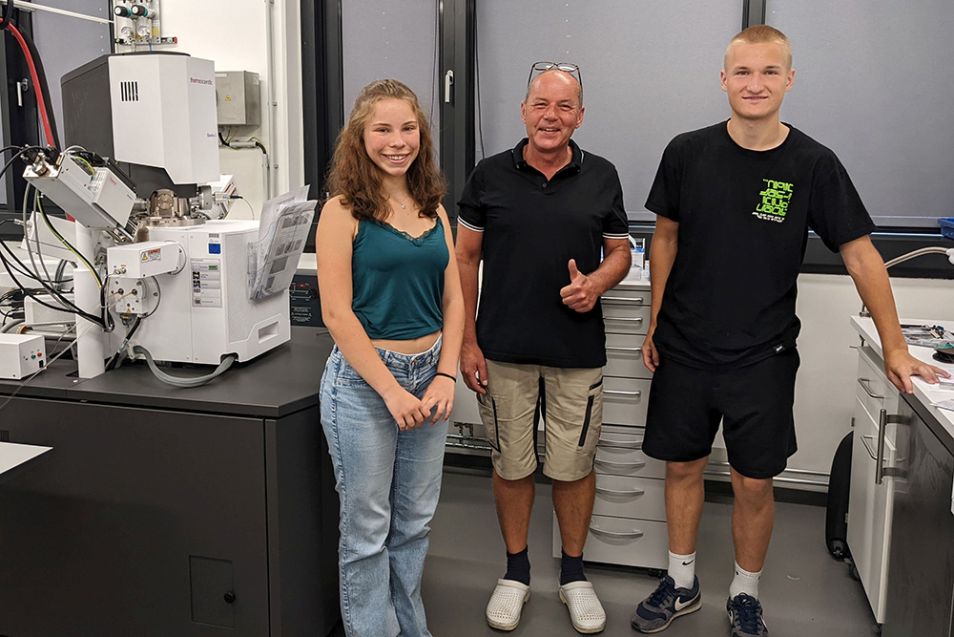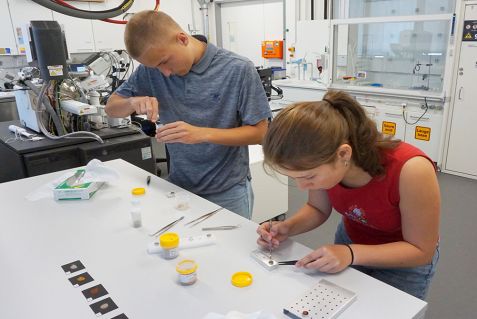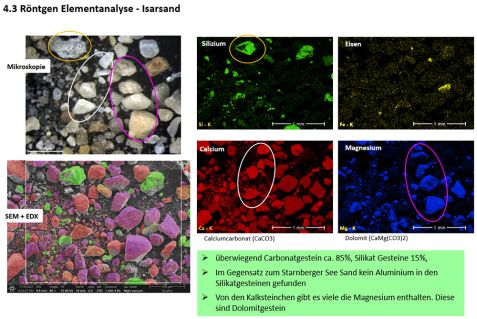MLZ is a cooperation between:
 > Technische Universität München
> Technische Universität München > Helmholtz-Zentrum Hereon
> Helmholtz-Zentrum Hereon
 > Forschungszentrum Jülich
> Forschungszentrum Jülich
MLZ is a member of:
 > LENS
> LENS > ERF-AISBL
> ERF-AISBL
MLZ on social media:

MLZ (eng)
Lichtenbergstr.1
85748 Garching
Not all sand is the same: an internship at the MLZ
Hidden behind a heavy door is the Hereon Materials Science Lab at the Heinz Maier-Leibnitz Zentrum in Garching. Under bright laboratory lights, surrounded by many quietly humming devices, two interns are sitting and analyzing the images of colorfully dyed structures of their project work. Marlene Piochacz from Gymnasium Olching and Andriy Senyshyn from Werner Heisenberg Gymnasium in Garching do not let their concentration be disturbed.
“We’re analyzing six different sands right now,” Andriy explains, pointing to the colored images on the screen. Sand? A topic that may not sound very interesting at first glance. But sand has a very special significance in the world, because it is one of the most important resources after water. Sand is an essential component of concrete and thus most of our buildings, bridges and roads are literally built on sand. Sand is becoming a scarce resource in the world and not all sand is suitable for use in construction.
But sand also surrounds us in other ways, such as in April 2022, when clouds of Saharan dust turned the sky orange and created a sepia filter over Munich. Such dust clouds are also driven by the wind across the Atlantic to South America, where they serve as mineral fertilizer for the rainforest.
A week as a scientist
So, this is a relevant topic that Marlene and Andriy will be dealing with for a week in July as part of their internship. In addition to the content-related topics, the two are learning in particular how to work well and in a structured scientific manner. “This begins with the planning of experiments, followed by the preparation of experiments, literature research, documentation, analyses and evaluations, and ends with questioning the results and comparing them with publications,” explains Armin Kriele, the interns’ supervisor and the person responsible for the Materials Science Lab.
In order to realize such an ambitious program in the short time available, thorough preparation is essential. Weeks before the internship, the applicants receive extensive training material on the analytical possibilities of the lab, as homework, prepared by Kriele in a student-friendly manner. He also invites the students to a preliminary visit. With this prior knowledge, the young people are then in a position to propose their own topic, which they work independently on until the start of the internship.

Concentrated, Marlene and Andriy are evaluating the data from the electron microscope and summarize their results in a presentation. © FRM II / TUM
According to Kriele, another important goal is for the students to understand and be able to operate very complex preparation and analysis equipment, such as the X-ray diffractometer or electron microscope (a cooperative device with JCNS), and to realize that in the end scientists only boil water. Thus, the practical courses offered by Kriele are very different from what is usually expected in this context. An unusually tight program, but the excitement of being able to operate even complicated equipment and the natural curiosity mobilize additional energies. Armin Kriele wants to offer them a lot, and for that he also demands commitment. But that comes naturally through the enthusiasm of being able to work on a project independently from start to finish. In this way, the students achieve a workload within a week that soon approaches the level of an Abitur paper. The intensive supervision pays off: “I get a lot of invigorating questions that really challenge me. This also gives me the opportunity to reflect on my own processes,” Kriele says happily. A particular concern of the physicist is that students who have no contact with research institutions through their parents also learn about this opportunity and have the chance to get to know the field of science.
From light microscopy to X-ray spectroscopy
Marlene and Andriy collected the six different sands from a wide variety of places: blown sand from the Sahara, sand from Lake Starnberg, sand from the Isar River and three sands from Roussillion in southern France from the famous ochre rocks. The two carefully prepared and analyzed each type of sand. “We start with the light microscope to get a first impression and make a kind of map for the later experiments,” Marlene explains. Then the samples were placed into the scanning electron microscope to get a close look at the surface of even the smallest sand grains at magnifications of up to one hundred thousand times. “We also examined the sands with X-ray spectroscopy to find out what elements the grains of sand are made of, whether they belong to the carbonate or silicate rocks, and where their color comes from,” adds Andriy.
Like sand on the sea?
The two summarized their findings in a 40-page presentation. They were able to show, for example, that the blown Sahara sand is particularly uniform and fine. This is because only the lightest grains can travel the long distance with the wind. They were also able to confirm the refutation of the myth that Sahara sand is generally not suitable for concrete because its grains are ground too round. Sahara sand is also very angular. The uniform size of the grains makes it unsuitable as a building material. Isar sand, on the other hand, consists of grains of different sizes of various minerals that can interlock well. So although sand is a dime a dozen, every sand is different. And the sand we use for concrete is becoming scarce.
“I was very amazed at how different sand can be,” says Marlene, “and I can well imagine going into science after school.” Andriy is also very satisfied with the internship project: “The internship was very exciting and I am taking a lot with me. But it also showed how exhausting the work of researchers can be. It challenged us to solve real problems.”
Other exciting internships Armin Kriele has already offered at MLZ:
- Shooting stars from the gutter
- Getting down to business – lab internship between predators and ruminants
- Is the DM really harder than the euro? A materials science study of DM, penny, euro and cent coins.
- Are the shells of land and sea shells and snails made of the same material?
- Where do the many different pebbles in the Isar come from? Examination of Isar pebbles using microscopy and X-ray diffraction.
MLZ is a cooperation between:
 > Technische Universität München
> Technische Universität München > Helmholtz-Zentrum Hereon
> Helmholtz-Zentrum Hereon
 > Forschungszentrum Jülich
> Forschungszentrum Jülich
MLZ is a member of:
 > LENS
> LENS > ERF-AISBL
> ERF-AISBL
MLZ on social media:





